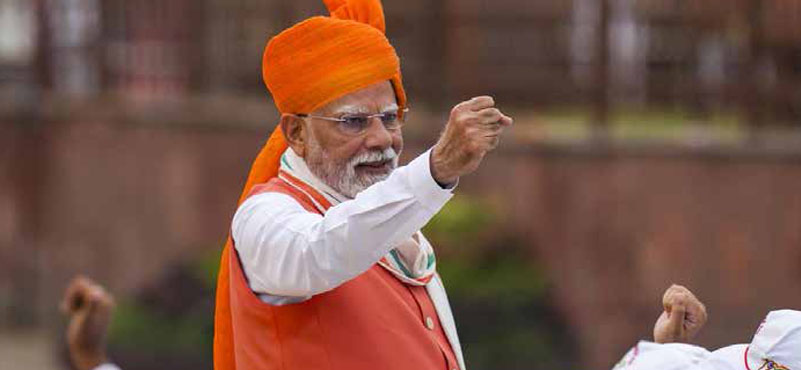Prime Minister’s address to the nation on the occasion of Independence Day from the ramparts of the Red Fort has profound symbolism. It is a link to India’s bloody and hard-fought freedom struggle and a declaration of the nation’s sovereignty, freedom, and its right to choose for itself. It is a nation’s collective reflection on its past achievements, present-day challenges, and opportunities for growth and development. In this backdrop, the prime minister’s speech is a moment in the nation’s journey to hit pause and celebrate its unity and collective pride. It is a time to take stock of its vision, policies, aspirations, and much more, making this an extraordinary address.
PM Modi’s 12th consecutive Independence Day speech, where he surpassed former PM Indira Gandhi’s record of 11 back-to-back speeches as the prime minister, was full of symbolism and deep political messaging. Speaking for a record 103 minutes, he touched upon critical domestic and international issues, making a strong pitch for atmanirbharta (self-reliance) as key to realising the dream of a Viksit Bharat (developed India) by 2047. In his speech, he showered fulsome praise on the RSS, launched a blistering attack on Pakistan, calling out its “nuclear” bluff, and underscored the importance of bolstering national defences using home-made technologies and systems. That he reiterated that the Indus Waters Treaty will remain in abeyance for the foreseeable future was a direct message to India’s neighbour and its backers elsewhere.
He exhorted India’s youth to double down on the ‘Make in India’ initiative, made a concerted outreach to the Tribal and Dalit communities, promised a sizable reduction in GST, and structural, regulatory, and policy changes to improve ease of doing business. Indicating that India will not open the dairy and agriculture sectors to US businesses – a thorny issue that has irked a mercurial Trump to launch a tariff war on India– the PM said he was standing like a wall, protecting farmers’ interests.
Here is a brief breakdown of the PM’s speech: What he said and what he didn’t!
Fulsome Praise of the RSS: The Political Meaning
One of the most notable aspects of the Prime Minister’s speech was his explicit acknowledgment of the RSS. Rarely has the RSS been publicly acknowledged, especially from the ramparts of the Red Fort. The first such instance dates back to 1963, when Prime Minister Nehru invited an RSS contingent to march alongside the armed forces in recognition of its role during the 1962 Sino-Indian War. PM Modi made detailed reference to the martyrdom of Dr. Syama Prasad Mookerjee for the “Constitution of Bharat” to achieve the ideals of “One Nation, One Constitution” by abrogating Article 370, underlining his deep ideological affinity with the Sangh. Having served as a Pracharak (a full-time worker dedicated to propagating the Sangh’s ideals) for many decades before entering active politics, the Prime Minister’s words of recognition were consistent with his background.
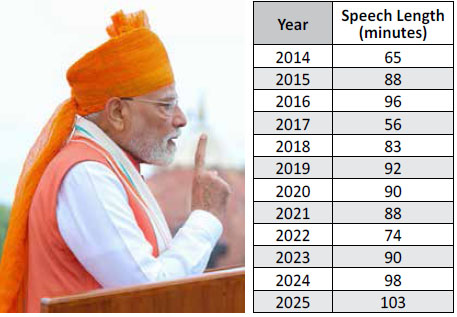 The timing, however, indicates a political calibration. Earlier this year, RSS chief Mohan Bhagwat remarked at a public forum that leaders should consider stepping back from public life after the age of 75 — a statement that some observers interpreted as a veiled reference to the Prime Minister, who will cross that milestone shortly. Reports of unease between the RSS and the BJP have circulated in recent years, intensified by party president J.P. Nadda’s statement during the 2024 election campaign and his repeated extensions due to delays in naming a successor. With a coalition government at the helm, the BJP cannot ignore the RSS any longer.
The timing, however, indicates a political calibration. Earlier this year, RSS chief Mohan Bhagwat remarked at a public forum that leaders should consider stepping back from public life after the age of 75 — a statement that some observers interpreted as a veiled reference to the Prime Minister, who will cross that milestone shortly. Reports of unease between the RSS and the BJP have circulated in recent years, intensified by party president J.P. Nadda’s statement during the 2024 election campaign and his repeated extensions due to delays in naming a successor. With a coalition government at the helm, the BJP cannot ignore the RSS any longer.
Since the 2024 general elections, the PM has led the reset in the relationship with RSS, even visiting the RSS headquarters – the first sitting prime minister to do so. The astute politician in him knows that the BJP must continue to win, especially in the crucial state elections of Bihar in 2025 and in Uttar Pradesh in 2027, to sustain the NDA coalition at the centre. Doing so will require a seamless cohesion between the RSS and the BJP. His comments on the RSS are both an assertion of his ideological roots and a signal that the party deeply values Sangh’s role in meeting governance and electoral challenges ahead.
Reading the Riot Act to Pakistan
The PM usually refrains from naming Pakistan. Observers would recall the prime minister’s address at the United Nations General Assembly (UNGA), shortly after his government had abrogated Article 35A and Article 370 in September 2019. Speaking after Imran Khan, the then PM of Pakistan, whose speech was centred on criticizing India’s move on Kashmir, PM Modi made no reference to Kashmir or Pakistan, focusing instead on global priorities such as renewable energy and climate change. The contrast was striking.
Pakistan was given no such pass this time. Barely 15 minutes into his speech, PM Modi tore into Pakistan. He reiterated India’s new playbook of treating the perpetrators, handlers, and backers of terrorism as one, signalling that India would not distinguish between those operating from across the LOC and the military establishment in Rawalpindi. Without naming individuals, he also appeared to give a stern warning to Pakistan’s new military leadership.
His speech signalled that India has considerably lowered the threshold against any such future terror attacks emanating from across the border. He declared that “blood and water cannot flow together,” essentially conveying that the Indus Waters Treaty will be held in abeyance for the foreseeable future, so long as Pakistan uses terrorism as a state policy to conduct low-intensity warfare on India.
The Success of Op Sindoor and Sudarshan Chakra
The prime minister expressed immense satisfaction with the success of Operation Sindoor, calling it a marvel of the ‘Make in India’ initiative. The PM noted that India’s swift and effective response was an outcome of a consistent and decade-long mission “towards self-reliance in the field of defence.” India conducted deep air strikes into enemy territory and bombed pre-designated targets in heavily guarded skies, underlining the country’s growing tech prowess and military readiness.
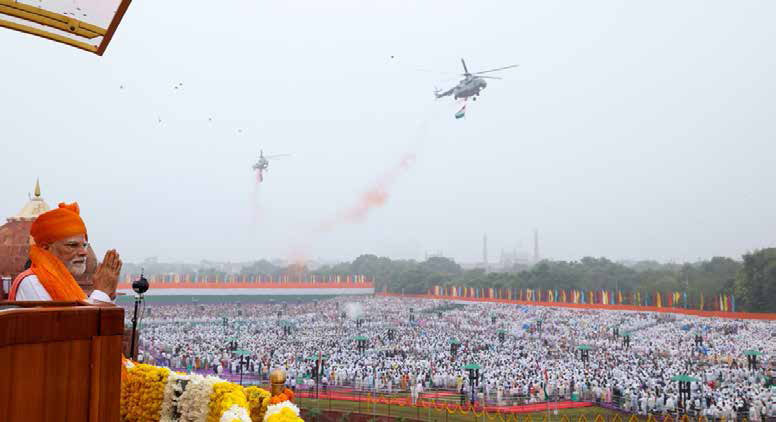
Buoyed by the spectacular performance of India’s air defence shield that neutralized Pakistan’s missile and drone attacks, PM Modi promised to double down on expanding the defence shield under Project Sudarshan Chakra. The upgraded air defence shield will cover all vital strategic and civilian areas, including hospitals, railways, and places of worship, and is slated for completion within the next ten years. The research and development of this precise and highly tech-driven new-age defence system will be undertaken domestically, he said, hinting that the system will be designed to give a hard-hitting response to enemy aggression.
The success of Operation Sindoor also underscored the export potential of homegrown defence systems. Brazil, for instance, has expressed interest in acquiring India’s nextgeneration Akash missile defence system. Brahmos, too, has emerged as a sought-after weapon system. Expect the government to place greater emphasis on defence modernization while leveraging such opportunities in the global arms market. With its symbolic resonance, Operation Sindoor is also likely to feature prominently in the BJP’s campaign narrative in politically significant Bihar, which goes to poll in November.
GST Reforms to Boost Exports and Domestic Spending
Dubbed the “Diwali bonanza,” the GST rate cuts announced by the Prime Minister during his Independence Day speech come amid mounting trade uncertainties and tariff wars. The next generation of GST reforms eyes simplifying the current slab structure by shifting most goods from the 12% slab to 5%, and several items from the 28% slab down to 18%. This new two-rate system will replace the existing four-rate structure, lowering the costs of multiple goods, spurring consumption, and providing a significant boost to small and micro, small and medium enterprises (MSMEs).
These tax reforms should help mitigate potential losses that India might face due to high tariffs imposed by the United States. The government’s decision to amend GST rates should cushion domestic businesses from the impact of escalating trade tensions and make Indian exports more competitive in the global marketplace.
Several reports indicate that the government is keen to roll out the reforms as early as Onam, which marks the beginning of a two-month-long festive season across the country. A quick recourse on GST reforms suggests that the government is digging its heels in for a prolonged tariff tiff with the US. And that India will negotiate a trade deal on its own terms.
Kisan, Dalit, Adivasi and Mahila Plank
A recurring theme in the Prime Minister’s Independence Day speeches has been the emphasis on farmers, Dalits, tribals, and women. He vowed to protect the farmers by standing like a “wall” to insulate them from any harm, indicating that the government was in no mood to negotiate a trade deal that allowed US dairy and agriculture firms access to Indian markets.
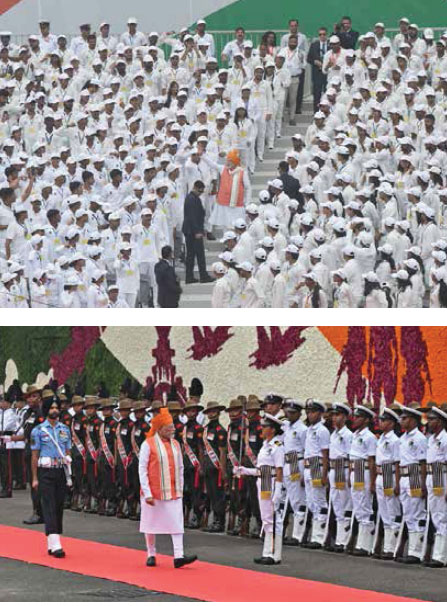 He highlighted the government’s relentless efforts to eradicate Naxalism, describing this as a “true tribute” to Bhagwan Birsa Munda on his 150th birth anniversary. He also linked government schemes like Jan Dhan Yojana to self-respect for the poor, underlining his disadvantaged background. He paid rich tributes to Mahatma Jyotiba Phule, noting that the government was working on his ideals of giving “priority to the backward.”
He highlighted the government’s relentless efforts to eradicate Naxalism, describing this as a “true tribute” to Bhagwan Birsa Munda on his 150th birth anniversary. He also linked government schemes like Jan Dhan Yojana to self-respect for the poor, underlining his disadvantaged background. He paid rich tributes to Mahatma Jyotiba Phule, noting that the government was working on his ideals of giving “priority to the backward.”
Focusing on women’s empowerment, or Nari Shakti, PM Modi recounted the transformation of millions of women – from becoming “drone didis” to “lakhpati didis,” to joining the armed forces, marching shoulder to shoulder with their male counterparts.
PM Modi’s emphasis on women’s empowerment underlines the growing clout of women voters in electoral outcomes. Women voters have increasingly played a decisive role in elections after elections, most notably in Maharashtra state assembly elections in 2024, where the Ladki Bahin Yojana helped the BJP-led Maha Yuti alliance bag an unprecedented 235 seats out of 288. PM Modi understands that the BJP must continue to tap into women voters to deliver electoral success.
His pre-emptive focus on protecting farmers is equally strategic to blunt any possible criticism of his government on farm issues. Given the narrative challenges that the government faced during the Farm Law protests in 2020-2021, perhaps the PM believes that strong posturing on farmers’ issues would ensure a favorable public sentiment.
Our Take
Self-reliance is no longer a choice but an imperative for India amid a nebulous global trade dynamics and geopolitical uncertainties. Supply disruptions, most notably in critical minerals, have created uncertainties, forcing businesses to make a quick pivot, even as the government scrambles to find alternate supply channels. Similar challenges overshadow India’s exports, particularly to the US, as additional tariffs are likely to make Indian products dearer and less competitive.
On the national security front, the 87-hour war with Pakistan has underscored the need for self-reliance in defense technologies. Modern-day wars, as the Operation Sindoor demonstrated, will be swift, technology-heavy, and will mostly be fought using drones, missiles, air defense systems, and comprehensive air power. With Russia engaged in a prolonged war with the NATO-led Ukraine and the US proving to be an unreliable partner, India has limited choices. PM’s speech must be analysed in the backdrop of these challenges that require careful policy-making and deft geopolitical manoeuvring.
The decision to overhaul the GST is a timely step in the right direction. It will lower product costs, boost competitiveness, and spur domestic consumption to keep the Indian economy vibrant. As his speech outlined, India must strengthen its domestic capabilities to maintain its superiority over its western neighbour, while credibly deterring its eastern neighbour to ensure peace on its Himalayan borders.
A nation can truly emerge as a power when half of its population actively participates in nation-building. Programs like Drone Didis and Lakhpati Didis are the brainchild of the PM and deserve praise for their conceptualization and implementation. States too should follow suit to empower womenfolk, beyond leveraging subsidies and welfare schemes designed to woo them for votes.
In his speech, PM also cautioned against concerted attempts to change the demography of bordering states, causing some unease among the “secular” populace who may view it as dog whistle. Truth be told, demographic change is real. How the government handles it to ensure that it does not affect genuine citizens and does not strengthen communal elements will be its real test. To sum up, his speech was a heady mix of realism and pragmatism, of hope and caution, of belief and reality checks.
A Throwback to 2014! PM’s First Speech: Then and Now
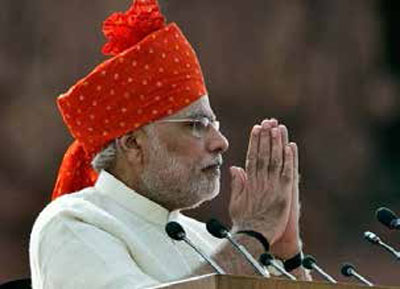 In his first speech from the ramparts of the Red Fort, PM Modi spoke passionately about how the country needed to feel the pain of women defecating in the open, often enduring grave bodily harm, waiting for the night to descend. He also spoke about the challenges that poor families, lacking access to formal credit, faced, leading to humiliation and, often, suicides. He questioned whether we could clean up our surroundings to capitalize on tourism, while announcing the launch of the Swachh Bharat Mission.
In his first speech from the ramparts of the Red Fort, PM Modi spoke passionately about how the country needed to feel the pain of women defecating in the open, often enduring grave bodily harm, waiting for the night to descend. He also spoke about the challenges that poor families, lacking access to formal credit, faced, leading to humiliation and, often, suicides. He questioned whether we could clean up our surroundings to capitalize on tourism, while announcing the launch of the Swachh Bharat Mission.
Credit where it is due. Eleven years later, India has transformed considerably, from the common sights of widespread open defecation to officially declaring all 741 districts Open Defecation Free under the Swachh Bharat Mission. Over 54.5 crore individuals – more than the entire population of the USA – have been added to the formal banking system under the Jan Dhan Yojana since 2014. Cleanliness, too, has certainly improved since then.
Clearly, India has a long way to go and much work remains to be done. Still, since 2014, the nation has marched ahead in many spheres, covering considerable ground on matters of inclusive growth, health and hygiene, and access to basic facilities. This has led to a considerable improvement in the quality of life of the most disadvantaged populace.
ABOUT THE AUTHOR
Shashank Shekhar is a marketing professional who writes on technology, politics, social developments and international relations. He is also a keen observer of astrophysics and space technology.

